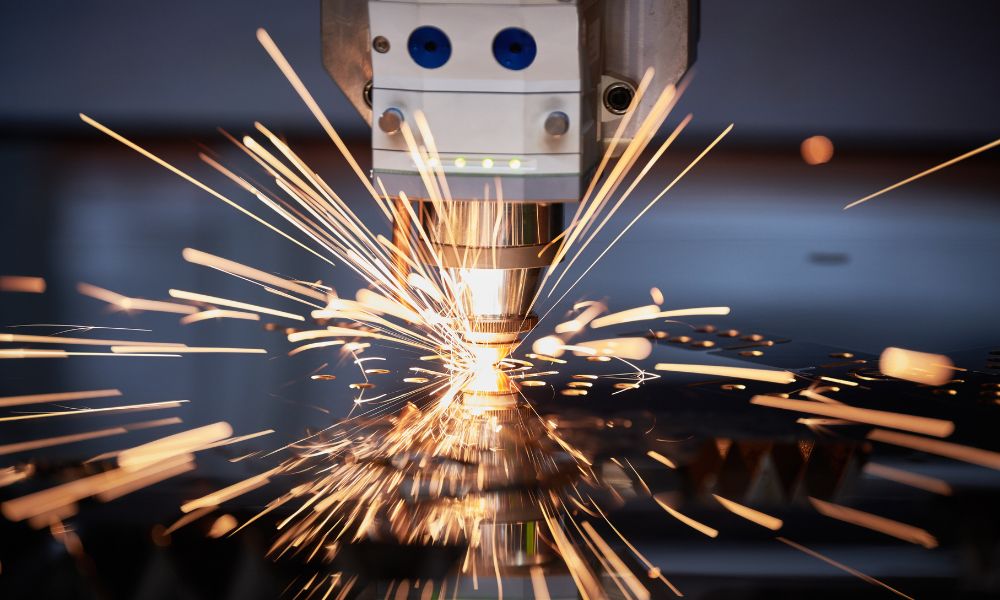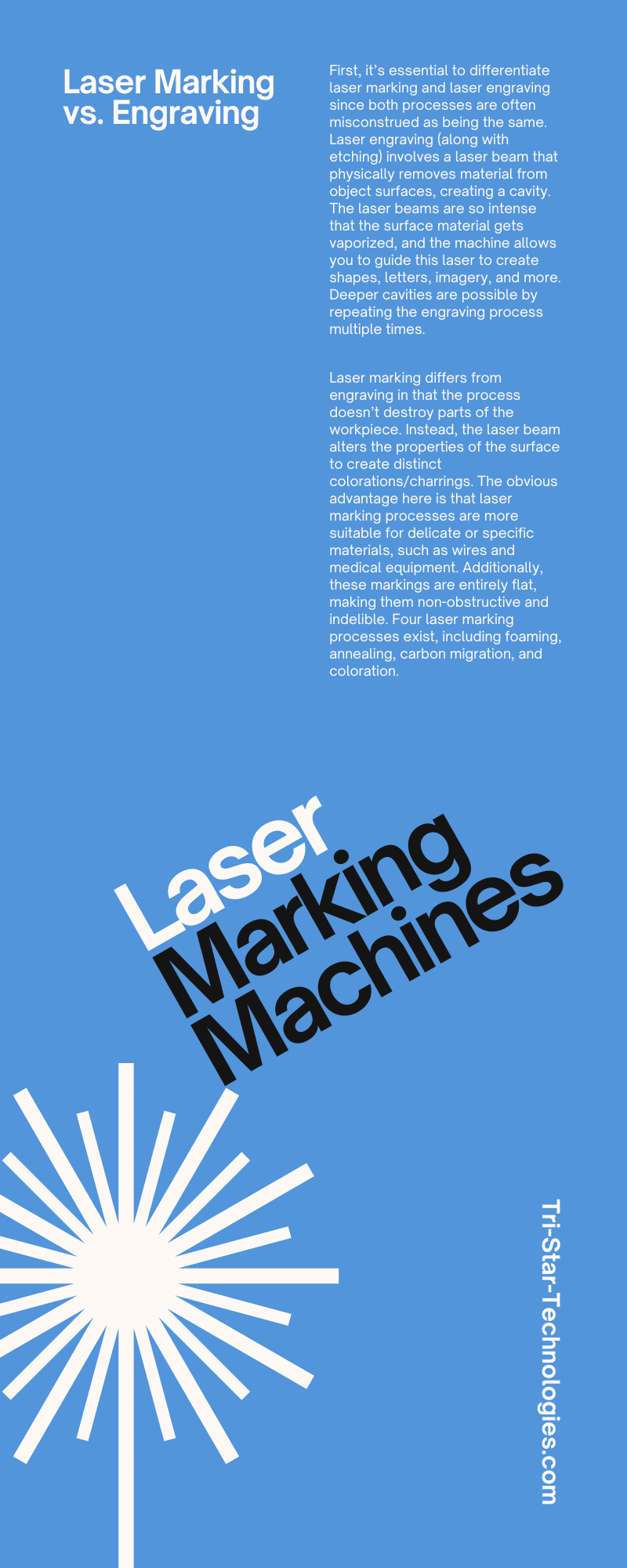Understanding Different Kinds of Laser Marking Machines

So, you’re in the market for a laser marking machine, but you’re not sure which device is best for your needs – luckily, there are only five different kinds of laser marking machines, making your decision much easier! Each device is best suited for specific applications, depending on the material, industry, and marking regulations specific to that industry. Read on to understand these machines better and ensure you purchase the most suitable device for your business.
LASER MARKING VS. ENGRAVING
First, it’s essential to differentiate laser marking and laser engraving since both processes are often misconstrued as being the same. Laser engraving (along with etching) involves a laser beam that physically removes material from object surfaces, creating a cavity. The laser beams are so intense that the surface material gets vaporized, and the machine allows you to guide this laser to create shapes, letters, imagery, and more. Deeper cavities are possible by repeating the engraving process multiple times.
Laser marking differs from engraving in that the process doesn’t destroy parts of the workpiece. Instead, the laser beam alters the properties of the surface to create distinct colorations/charrings. The obvious advantage here is that laser marking processes are more suitable for delicate or specific materials, such as wires and medical equipment. Additionally, these markings are entirely flat, making them non-obstructive and indelible. Four laser marking processes exist, including foaming, annealing, carbon migration, and coloration.
Foaming occurs when a laser beam hits a polymer, which causes the material to melt and create foamy bubbles. Annealing causes metal oxidation and discoloration, so it’s primarily used on metals such as steel, stainless steel, and titanium. Laser coloration works best on metals and plastics – utilizing pulse frequencies and varying widths of laser beams, coloration creates different shades underneath the surface of a material. Lastly, carbon migration is a darkening method used on metals and metal alloys. Now that you’re familiar with the key differences between laser marking and engraving, we can explore the five various types of laser marking machines.
UV LASERS
UV, or ultraviolet, is part of the electromagnetic spectrum and features a wavelength between 10 nm and 400 nm. The human eye can’t see ultraviolet light since its wavelengths are too short for visible light. But how does this invisible light source relate to laser marking? Using long wavelength UV (UV laser marking machines typically emit 355 nm), these specific lasers create chemical changes on surfaces without ionizing radiation. As a result, UV laser markers are capable of fluorescing safely!
However, there are plenty of other applications for these devices, especially for “cold markings” where laser heat isn’t required. Additionally, the accuracy and sensitivity of UV laser beams are highly useful for micro-marking medical and electrical equipment (microchips, circuit boards, etc.), aerospace and defense products, wiring and cables, solar panels, and low-heat tolerant plastic materials.
UV laser beams are even safe for marking glass materials without causing micro-fracturing. And thanks to the many advancements in UV marking technology, UV laser marking machines are more portable and powerful than ever – our selection of devices here at Tri-Star Technologies ensures your marked products are accurate and meet industry-specific standards/regulations.
GREEN LASERS
Green lasers are within the green near-IR visible light spectrum, with a wavelength of 532 nm and a power range of 5 to 10 watts. This specific wavelength makes green laser marking devices highly suitable for marking reflective/sensitive materials, such as silicon wafers.
While other machines can mark these materials, green light’s precision is superior. Additionally, these machines can make tight spot sizes of up to 10 µm and work well in environments where shock, vibration, and dust are common. However, these devices are relatively expensive and mainly geared toward the most sensitive materials.
FIBER LASERS
Fiber lasers are extremely powerful, with power capabilities maxing at 50 watts. Fiber laser marking machines are so robust that they’re highly suitable for deep etching and engraving processes. However, they’re also extremely fitting for annealing metal surfaces. Depending on the material, a fiber laser produces color markings in various shades of yellow, red, and green.
Other applications for fiber laser marking machines include color marking labels and packaging – this process removes an existing color marking, revealing another color/material underneath. Unfortunately, extraordinarily thick or reflective materials are difficult to mark with a fiber laser.
CO2 LASERS
CO2 lasers are primarily used on wood, glass, ceramics, quartz, and other non-metal materials. Additionally, CO2 laser machines can mark organic materials and even some fabrics, thanks to their 10,600 nm wavelength. The most common applications for CO2 lasers include barcode and serial number production.
Some facilities use CO2 laser devices for other purposes; however, this technology is widely regarded as outdated for most industrial applications. Furthermore, finding more powerful CO2 laser machines is difficult and expensive. Unless you work with organic materials, certain plastic polymers, or certain stones, a CO2 laser marking machine isn’t the best investment for your needs.
MOPA LASERS
MOPA, or Master Oscillator Power Amplifier, laser marking machines use a laser and optical amplifying component to create a more powerful beam. This is in contrast to fiber lasers, which only blast laser beam pulses that last less than a second.
So, what is the advantage of using a supercharged MOPA laser marking machine? MOPA lasers produce highly accurate, multi-color markings for stainless steel and high-contrast dark markings on anodized aluminum. Additionally, this device is perfect for creating high-contrast markings on various plastics. However, most facilities opt for more affordable fiber lasers since the MOPA machine has limited applications.
As you can see, there is a laser marking device for any industry, material, and need! And by understanding the different kinds of laser marking machines, you can ensure your business invests in the correct equipment. At Tri-Star Technology, we carry UV machines and wire processing equipment suitable for automotive, manufacturing, aerospace and defense, pharmaceutical, and cable/wire applications. Check out our selection today and find the perfect product for you. Additionally, you can contact our friendly team for further information on the UV laser marking process and related machinery.



